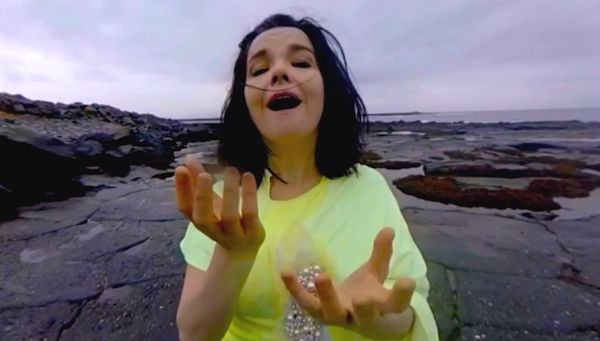[Could presence ‘save’ the music industry? This is from The Memo, where the original story includes the Björk and Muse videos and a screenshot from the U2 video; I’ve corrected several typos. –Matthew]
VR: Let Björk serenade you on a beach & help save the music industry
Shaking up the music industry: How personal, immersive performances could empower indie filmmakers, musicians and artists.
By Kitty Knowles
18 November 2015
Björk stands on a near-black Icelandic beach, unfolding her arms out towards you. She looks you in the eye, warbling her way over delicate notes.
Waves crash behind her, and her lime green dress flaps around in the breeze before she totters off over the stoney landscape. Soon there is not one, but several Björks serenading you in this starkly beautiful setting.
The scene is not real, of course, it’s the first ever music video to be filmed in virtual reality. But it’s still a super-fan’s dream, and these new immersive experience have the power to shake up the music industry.
This week, The Memo met Solomon Rogers, the man who founded VR studio REWIND and helped to create Björk’s “Stonemilker” experience, to find out more.
“Björk is doing a performance for you,” says Rogers, whose team created Björk’s latest release with the help of VR studio Vrse. “She looks at you in the eyes, she stands in front of you and sings to you.”
“We also worked with the BBC to do binaural audio, that’s audio placed within the world, so as you turn your head, it sounds like she’s moving around you, and the placement of the strings, and the drums, and the rest of the instruments, are around you as well. That level of immersion changes from just having 360 video that you’re looking at and makes you feel like you’re in the space.”
“People have taken the headset off in tears because they’ve felt that they’ve had a personal performance with someone that they’ve always idolised,” he adds.
Created last year for an installation in MoMA, New York, Björk’s VR experience was the first ever immersive 360 virtual reality music video. Since then, musicians including U2 and Muse have followed suit in releasing their own virtual reality singles.
“Each of them have taken a different tact,” says Rogers of this month’s VR releases. “With the U2 experience you start off with Bono singing to you on a stage, and then the other band members join around you and all of a sudden you’re whisked away around the world: you’re taken to other realities really very quickly. The Muse piece, it’s a different piece completely.”
“But all of them have one thing in common: they don’t follow the same traits that traditional music videos have down, it’s not high action, it’s not high impact, it’s not high edits.”
“VR experiences don’t need bells and whistles,” Rogers explains. “It’s just very personal. With Björk it’s just her singing to you on a beach, that’s the whole piece.”
“If we watched that video just through a traditional 16:9 frame it wouldn’t have any of the impact it does when you are immersed in that world.”
VR can help save the music industry
Virtual reality has the power to rejuvenate an industry struggling to sell music as a commodity, says Rogers, and this week Björk will be releasing “Stonemilker” as an iPhone and Android app that you can download and run on many VR headsets.
“You dock your phone into a headset, put the headphones on and suddenly you’re with her,” Rogers explains.
“A music video you wouldn’t pay for, and selling singles are incredibly hard,” he says. “But people will pay for an immersive VR experience because it’s not just a throwaway piece of content: a piece of music is a small form narrative and by adding in this new medium, the stories that can be told have a real value.”
Selling each experience for just a few pounds will enable musicians to make immediate money from new releases, says Rogers.
“Because we can sell those experiences on the Apple Store and we’re used to buying apps, as a distribution model, as a monetisation model, indie filmmakers or musicians can create meaningful pieces of content that they will be able to sell direct,” he explains.
“VR will empower a new generation of musicians to make art in a new format and sell directly, which will support them to have actual careers creating a new art form.”
Björk may stand alone on her beach, but VR music will soon become a very crowded and exciting arena.
